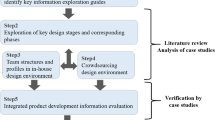Abstract
CAD-FEA coupling has been the subject of research for a long time. Initially developed with the aim of connecting single applications, requirements due to the interfaces rose along with increasing application of computer-aided methods in product development. The introduction of the termproduct data model in combination with object-oriented technology, allowed progressive work towards the integration of product data. First results have been given in form of a standardized product data model called STEP (ISO 10303) to serve for CAE product data exchange. The authors have had the opportunity to examine the data model introduced by STEP in general and depicting the CAD-FEA connection as well as to implement a prototype STEP interface.
The article first presents some fundamentals of product data modeling and related aspects of design and analysis product data, then gives a survey of the case study being done in CAD-FEA coupling with STEP and in conclusion sketches the concept of an object-oriented CAD-FEA integration model to allow for bidirectional and process conform data exchange.
Similar content being viewed by others
References
Anderl, R. (1993) CAD-Schnittstellen, Hanser, München
Steinmetz, O. (1995) Die Strategie der Integrierten Produktentwicklung, Vieweg, Braunschweig
ISO (1994) Standard for the Exchange of Product Model Data—Part 1—Overview and Fundamental Principles
ISO (1994) Standard for the Exchange of Product Model Data—Part 42—Geeometric and Topological Representation
Zintl, G. (1993) ProSTEP-Projektergebnisse, ProSTEP eV, Berlin
Potthast, A. (1995) Datenaustausch zwischen STEP und ACIS, CAD-CAM Report, 3, 74–78
Greening, R.; Brocke, A.; Rupprecht, T.; Webster, M. F. (1996) Data Accessing Methods in STEP and their Software Implementations, VDI-Fortschrittberichte, Reihe 20, Nr. 214, pp
Fröhlich, P. (1994) FEM in der Konstruktionsabteilung. CAD-CAM Report, 7, 122–133
Helpenstein, H. J. (1993) STEP als Verbindung zwischen den Systemen, Konstruktion, 45, 316–320
N. N. (1995) CAD-Systeme Mechanik — UNIX Betriebssysteme, CAD-CAM Report, 9, 98–108
Kretschmar, H. (1994) Computergestützte Bauplanung, Verlag für Bauwesen GmbH, Berlin
ESPRIT-Progam 8894 (1996) The Generic Engineering-Analysis Model, TNO Building and Construction Research, Delft
Stroustrup, B. (1992) Die C++ Programmiersprache, Addison-Wesley, München
Plocker, W.; Soethout, L. (1995) The COMBINE SDAI Interface Kit, TNO Building and Construction Research, Delft
Libes, D.; Clark, S. (1992) The NIST Express Toolkit-Lessons Learned, Proc. of the 1992 EXPRESS User's Group Conference, Dallas, Texas
Singhal, V.; Kakkad, S.V.; Wilson, P.R. (1995) Texas: An Efficient, Portable Persistent Store, Department of Computer Sciences, The University of Texas, Austin, Texas
Gabbert, U.; Weher, P. (1995) Das Produktdatenmodell als Integrationsmodell von Konstruktions- und Berechnungs-daten, Preprint 2 der Fakultät für Maschinenbau der Otto-von-Guericke-Universität Magdeburg
Berger, H.; Gabbert, U.; Wehner, P. (1995) Objektorientierte Analyse und Design der FE-Netzgenerierung großer Baugrund-Tragwerk-Systeme, Forum Bauinformatik, VDI-Fortschrittberichte, 20/173, 1–7
Gabbert, U.; Berger, H. (1989) FEMDAS, Datenschnittstelle für Finite-Element-Modelle, TGL 44640, Berlin, Amt für Standardisierung
Unruh, A.; Anderson, D.C. (1992) Feature-based modeling for automatic mesh generation, Engineering with Computers, 8, 1–12
Shephard, M.S. (1986) Geometric modeling needs of finite element modeling. Geometric Modeling for CAD-Applications, Elsevier Science, Rensselaerville
Gustav, C. (1994) Informationstechnische Kopplung von CAD und CAP durch eine flexible Konstruktionsdatenaufbereitung, PhD Thesis, Fachbereich Maschinenwesen. Universität Kauserslautern
Rumbaugh, J. et al. (1993) Objektorientiertes Modellieren und Entwerfen, Hanser, München
Demmert, P. (1995) Strategien zur objektorientierten Modellierung von Aufgabenstellungen der numerischen Tragwerksanalyse, PhD Thesis, Institut für konstruktiven Ingenieurbau, Ruhr-Universität Bochum
N.N. (1995) ACIS References, Spatial Technology, Boulder, Colorado
Lührsen, H.; Krebs, T. (1995) STEP Databases as Integration Platform for Concurrent Engineering, Institute of Data Base Systems, University of Erlangen
Dobrowolny, V. (1994) Über die semantische Modellierung einer Produktwelt in Zeit und Raum, Preprint 8 der Fakultät für Informatik der Otto-von-Guericke-Universität Magdeburg
Genderka, M. (1995) Objektorientierte Methode zur Entwicklung von Produktmodellen als Basis integrierter Ingenieursystem, PhD Thesis, Fachbereich Maschinentechnik, Universität Paderborn
Author information
Authors and Affiliations
Rights and permissions
About this article
Cite this article
Gabbert, U., Wehner, P. The product data model as a pool for CAD-FEA data. Engineering with Computers 14, 115–122 (1998). https://doi.org/10.1007/BF01213585
Issue Date:
DOI: https://doi.org/10.1007/BF01213585



